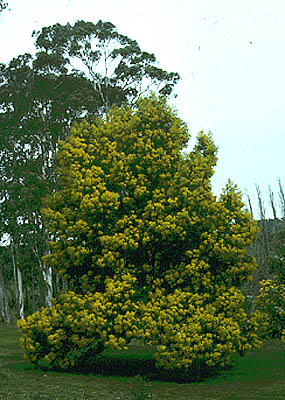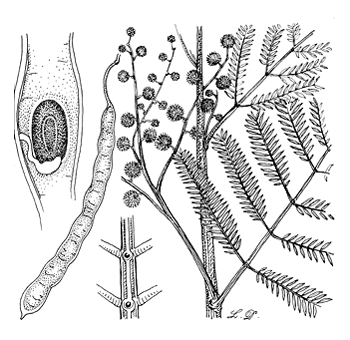Family: Fabaceae
Acacia decurrens

Citation:
C. L. Willdenow, Sp. Plant., ed. 4, 4:1072 (1806).
Derivation: decurrens (Latin)--running down, refers to the rachis of the leaves running down or extending below the point of insertion on the stem. Mimosa decurrens Donn, Hort. Cant. 1:114 (1796), nomen nudum. Synonymy: Racosperma decurrens (Willd.)Pedley, Austrobaileya 2:358 (1987). , Acacia decurrens, Mimosa decurrens Common name: Early black wattle
Description:
Medium sized trees 10-15 m high, canopy conical or rounded, dark green; branchlets prominently angled with wing-like ridges, smooth, dark grey on the trunk. Leaves bipinnate, dark green decurrent; petiole angular, 1.5-2.5 cm long; rachis angular, 4-12 cm long with a raised gland just below the junction of each pinnae pair; pinnae 5-15 pairs; pinnules 15-35 pairs which are well separated from each other, linear, 5-14 mm long, 0.5-0.75 mm broad, usually glabrous. Inflorescences racemose or panicled; flower-heads globular, bright yellow, 25-30-flowered; peduncles glabrous or with a few scattered hairs, 3-6 mm long; flowers 5-merous. Legumes linear, 4-10 cm long, 5-6 mm broad, straight or slightly curved, raised over seeds, dark brown, glabrous, margins slightly constricted between seeds. Seeds longitudinal in legume, ellipsoid; funicle short, expanded into a small aril.
|
|
Distribution:
|
Introduced from eastern States. A garden escape in parts of the Southern Lofty region, mainly in the Adelaide Hills area, also in the South-Eastern region around the Penola-Mount Gambier area. Soils; sandy neutral yellow duplex and hard neutral red duplex. Rainfall approx 700-1 200 mm. Also Qld, N.S.W., A.C.T., Vic. and Tas.
S.Aust.: NL, SL, SE.
|
Flowering time: July — September. |

SA Distribution Map based
on current data relating to
specimens held in the
State Herbarium of South Australia
|
Biology:
No text
Related taxa:
Acacia dealbata has a similar habit but differs in having glaucous silvery more crowded and shorter pinnules, and in having pruinose not winged branches. Acacia mearnsii can be distinguished mainly by the soft more or less appressed pubescence on all parts of the bipinnate leaves. Hybrid populations with A. baileyana have been recorded in the Adelaide Hills area.
Taxonomic notes:
For some results of seven pre-sowing treatments on seed germination see Aveyard (1968).Wool may be dyed with A. decurrens leaves to yellow or green depending on the mordants used, Martin (1974). Although A. decurrens is listed as being grown in the Adelaide Botanic Gardens in 1871, 1878, the first recorded specimen in the herbarium is from Aldgate made in 1944 by Professor J. B. Cleland. A. decurrens is now naturalised in New Zealand, Webb et al. (1988), and occasionally persists in California.
Cultivation:
Well known as an ornamental, shade, or shelter tree, preferring the cooler higher rainfall areas. The bark contains a reasonably high percentage of tannin. It was previously planted in South Africa where it has spread out of control. Very fast growth rate.
Author:
Not yet available
References:
Source:

|

